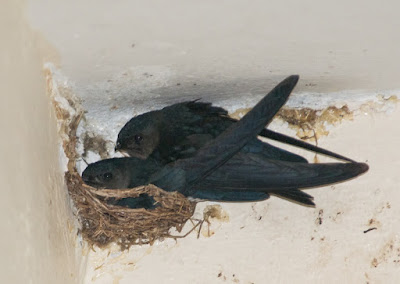In March 2014, I was invited to address the Sabah Society ion the ivory and rhino horn trade, the subject of my then most recent book. Part of the bait luring me to Kota Kinabalu was that Lord Cranbrook was to address the Society on March 11, the following night. I stayed with my friend Hezekiah Lim, and on the day of his talk the three of us drove out to Kota Belud, an agricultural area northeast of Kota Kinabalu, for a bit of morning birding.
Actually, I was able to start birding without even leaving Hezekiah's house, where Glossy Swiftlets (Collocalia esculenta) were nesting under his front porch - an auspicious start to the day, as Lord Cranbrook is the world's leading authority on swiftlets (the subject, indeed, of his talk that evening, the launch of the second edition of his Swiftlets of Borneo).
Our most productive stop, once we got under way, was a flooded paddy filled with foraging egrets (you can see them behind Lord Cranbrook in this photo). The fence just behind him was interesting in itself, and brought back some childhood memories.
The fence was made of Quickstick (Gliricidia sepium), a tree named because it sprouts readily from cuttings (including wood used for fenceposts). A native of Central America, it is widely planted in the West Indies. Quckstick fences are a particularly common sight in Jamaica, where I spent one of the happiest years of my childhood. I don't see them much in Sarawak, but I gather they are common in the Philippines, Sabah's nearest neighbour.
Anyway, the concentration of egrets was easily explained: the paddy owner was running a large and noisy machine (a combine, perhaps?) back and forth through his rice field, and the resulting disturbance to local fishes, frogs and insects was creating a feeding bonanza for the birds.
Commonest among the egret horde were Eastern Cattle Egrets (Bubulcus coromandus) in various stages of plumage (in the top two photographs you can just see a Little Egret (Egretta garzetta) joining the fray at the top left.
Great Egrets (Ardea alba) (or, if you like, Eastern Great Egrets (E. modesta)) and Intermediate Egrets (Egretta intermedia) joined in in smaller numbers; here is a nice size (and neck length) comparison between the two species.
The mixed-species melee (here including Little, Eastern Cattle and Intermediate Egrets) was fascinating to watch.
Amidst the flurry of egrets were a few darker birds - pond herons, for once in breeding plumage. Pond herons are all but impossible to identify the way I usually see them, in juvenile or non-breeding plumage, and they are hard to find in any plumage near Kuching. I had previously seen definite, identifiable Chinese Pond Herons (Ardeola bacchus) and Indian Pond Herons (A. greyii) in, respectively, China and India, and birds I had seen in West Malaysia I had always written off as Chinese, the more likely species there (at least in winter). Here, though, in resplendently identifiable breeding colours, was the one Malaysian species I had yet to definitely see: the Javan Pond Heron (Ardeola speciosa), posing amidst a group of Eastern Cattle Egrets.
Here, the birds are joined by a Whiskered Tern (Chlidonias hybrida), also attracted to the turmoil.
Javan Pond Herons are the only pond herons to breed in Borneo, but they are (according to Clive Mann's The Birds of Borneo, the standard checklist) probably commonest in the southern (Indonesian) part of the island.
This bird, with a Great Egret for size comparison, is not as fully into breeding colour as the first, but is still identifiable as a Javan. I don't get a "life" heron every day, so by this time I was feeling quite pleased with myself.
Egrets were not the only birds in the area: here are more Whiskered Terns...
...and an Oriental Pratincole (Glareola maldivarum), seemingly unmoved by the pandemonium.
We watched the feeding swarm for sometime, but eventually the birds decided to take off - so after a few parting flight shots, so did we.
Nothing else was quite as exciting as the egrets, but I did take a few photos of this dark-tipped female Neurothemis terminata. I'm still not sure why some Neurothemis females have dark wingtips but not others. However, thanks to a handy comparison chart on the 'Dragonflies of Sabah' web site, I am reasonably sure that this is N. terminata (with more black on the abdomen) and not the otherwise-siimilar N. fluctuans.
I am always happy, though, to encounter the Striated Grassbird (Megalurus timoriensis), especially when one poses as nicely as this one. I find it particularly handsome, and I am still waiting for one to show up around Kuching.
Our morning excursion done, we dropped Lord Cranbrook at his hotel and devoted the afternoon to other pursuits (including trying to locate a supply of dried shrimp for Eileen in the local market. I did take time, though, to photograph yet another Great Egret (Ardea alba), this one in town..
...and in the evening, before going to hear Lord Cranbrook's talk, I took time to enjoy the sunset over the offshore islands of Tunku Abdul Rahman National Park, where I snorkeled on my firts trip to Sabah, twenty-two years earlier.

































No comments:
Post a Comment